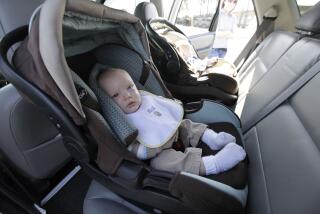Car Booster Seats Drive Down Risk of Injury for Children, Research Finds
- Share via
WASHINGTON — Parents who invest $20 to $80 in a car booster seat for their child can cut that child’s risk of injury in a crash by more than half, a national study published today concludes.
The study in the Journal of the American Medical Assn. provides the first scientific evidence that the new safety products are effective in protecting children ages 4 through 7 from the forces in a crash, as well as from serious injuries caused by ill-fitting adult belts.
Parents have become diligent about putting infants and toddlers in child safety seats, but auto safety experts term older youngsters “forgotten children” because of the lack of suitable protection for them. Auto accidents are the leading cause of death for children after the first year of life.
“We hope this helps parents and state legislatures set a new standard for what is considered normal in the car,” said Dr. Dennis Durbin of Children’s Hospital of Philadelphia, which conducted the study with State Farm Insurance.
The findings also called into question the scope of California’s booster-seat law, which applies to children only until their 6th birthday. Up to age 4, children in California must ride in child safety seats.
Booster seats are much like pads, raising a child from the car’s seat so that adult lap and shoulder belts can be properly positioned on the child’s hips and shoulders. Boosters can be purchased at discount outlets, toy retailers and baby stores.
Riding in a booster seat helps keep a child from coming loose in a crash, or from suffering abdominal and neck injuries caused by the adult belts.
Researchers followed 4,243 children ages 4 through seven 7 who were in 3,616 crashes reported to State Farm from 1998 to the end of 2002. They found that using booster seats reduced the risk of injury by 59% when compared with the use of adult belts alone. Durbin also said children using booster seats were 78% less likely to be injured in a crash than unbelted children.
None of the children in booster seats in the study suffered abdominal or neck injuries caused by adult seat belts, a problem so common that doctors call it “seat belt syndrome.”
“We certainly did not expect belt-positioning boosters to eliminate those kinds of injuries, but that is exactly what we have found,” Durbin said.
All states require parents to put very young children in child safety seats, but fewer than half have booster seat laws. California is among those with a requirement, but the study showed it to be inadequate. Statistics show a sharp drop in booster seat use after a child reaches 6.
“California might want to consider revising their law if they want it to be based on the current scientific data,” Durbin said.
The author of the California law said she will try to extend the reach of the legislation to older children. State Sen. Jackie Speier (D-Daly City) said she had tried to get children covered up to age 8, as recommended by the federal government. But Speier said she had to compromise to convince Gov. Gray Davis to sign the bill, which took effect last year.
“I have an 8-year-old daughter who weighs 55 pounds and she still rides in a booster seat,” Speier said. “I feel very strongly the law should have covered children up to age 8.”
The National Highway Traffic Safety Administration recommends that children up to age 8 or 57 inches tall ride in booster seats.
But of 19 states with booster seat laws, only six require children to ride in the seats until they are at least 8.
Durbin said he hopes the study will convince states to strengthen their laws.
“Until now, many parents felt that once a 4-year-old got out of a car seat, they were ready for the adult belts, but this study shows that is not really the case,” he said.





